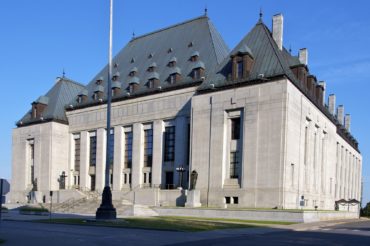
Top court could hear disputed claim arising from $550-million ponzi scheme loss
November 5, 2018 by Greg Meckbach
Print this page Share
A major bank’s disputed $300-million professional liability insurance claim – arising from a Ponzi scheme in Florida – could reach the Supreme Court of Canada.
Toronto-Dominion Bank bought an insurance policy from a syndicate of insurers, including Lloyd’s Underwriters in 2009.
TD is suing the insurers for breach of contract. TD’s allegations have not been proven in court.

TD paid a grand total of nearly US$500 million (including legal fees) to settle lawsuits with American investors after a Ponzi scheme unravelled. Former employees of TD (one of whom was sent to jail as a result of a plea arrangement) were involved.
TD wanted to claim under the professional liability section of its policy, titled “bankers comprehensive crime, professional indemnity and directors’ and officers’ liability programme.”
The overall policy limit is $300 million, with a deductible of $100 million.
In the alternate, TD is asking the courts to rule that it is covered by the fidelity section of its policy – in the event that coverage is excluded under the professional liability section.
In 2016, Judge Sean Dunphy of the Ontario Superior Court of Justice ruled partly in favour of the bank, in Toronto-Dominion Bank, N.A. v. Lloyd’s Underwriters. That 37-page decision made a plethora of findings, one of which was that the loss of money on the ponzi scheme was a “direct loss” to TD.
The insurers successfully appealed.
The Supreme Court of Canada announced Oct. 26, 2018 the TD is appealing the Court of Appeal for Ontario’s ruling, released Dec. 21, 2017 in Toronto-Dominion Bank, N.A. v. Lloyd’s Underwriters.
The Court of Appeal for Ontario’s ruling does not mean the insurers are off the hook. What the appeal court did say was that a trial judge still needs to determine whether the money TD paid on lawsuits constitutes a “direct financial loss” within the meaning of the insurance policy.
So Dunphy erred in making the ruling that he made (that TD’s loss was a direct financial loss) by partial summary judgement, the Court of Appeal for Ontario ruled.
There are several ways the Supreme Court of Canada could handle this. A three-judge panel has to decide whether or not TD should be granted leave to appeal. If they reject TD’s application, then the appeal does not get heard by the top court. If they accept TD’s application, then the court will hear arguments from both sides and could – potentially – restore Dunphy’s original ruling.
The lawsuits against TD arose from a ponzi scheme operated from 2005 until 2009. TD says it paid US$443.3 million to settle those and an additional US$46 million in legal defence costs. The U.S. dollar is trading at Cdn$1.31, meaning TD’s loss is about $553 million.
The scheme was perpetrated by former lawyer Scott Rothstein, who was later sentenced to 50 years in jail.
The Florida bank that Rothstein was using was acquired in 2008 by TD.
TD was sued by 19 different plaintiffs in the U.S., Dunphy noted. One plaintiff – Coquina Investments – got US$67 million from TD.
The insurers underwriting the $300 million policy for TD include several Lloyd’s syndicates, as well as Aspen, AIG Canada, Allied World, Arch Canada, Axis, Chubb, Endurance Specialty, Houston Casualty Company, Liberty Mutual and Markel.
The insurers argued – using case history – that the intent of a fidelity insurance policy is to cover the client’s own assets from employee dishonesty but not to provide third-party liability coverage for the risk of employee dishonesty.
In TD’s banker’s policy, there is a preamble – which includes the reference to “direct financial loss” – as well as 19 different insuring clauses.
TD is arguing that the phrase “direct financial loss,” is supposed to apply not only to money that TD lost but also to money that the victims lost after transferring their funds to TD.
The insurers counter that the phrase “direct financial loss” does not apply to third-party claims unless an insuring clause specifically says so.
Dunphy erred in not accounting for how the wording of the professional liability section “might inform” the interpretation of the fidelity section, the Court of Appeal for Ontario ruled in 2017.
The professional liability section covers losses resulting from “wrongful acts” but excludes “dishonest, fraudulent or criminal act or omission of any of the Assureds.”
TD says in three of the lawsuits against it, two clauses in the insurance policy apply. One is an insuring clause for fidelity, which covers the bank for losses “caused by dishonest or fraudulent acts by employees” with the intent to either cause the bank to sustain such losses or with the intent of obtaining in “improper personal financial gain.”
TD also says Clause 39 – which is neither in insuring clause nor an exclusion clause – applied. Clause 39 is titled “ownership” and states that the insurance policy applies to loss of funds or property either “owned by” the insured, held by the insured “in any capacity” or for which the insured “is legally liable and/or responsible or for which the Assured has instructions to insure.”
TD “owned legal title” at one point to money received from the investors who were victims of the ponzi scheme, Judge Dunphy wrote.
TD was supposed to safeguard this money for the investors but some of that money instead was credited to accounts of fraudsters.
“That misappropriation resulted in an immediate loss to TD,” Dunphy wrote in 2016.
Have your say: